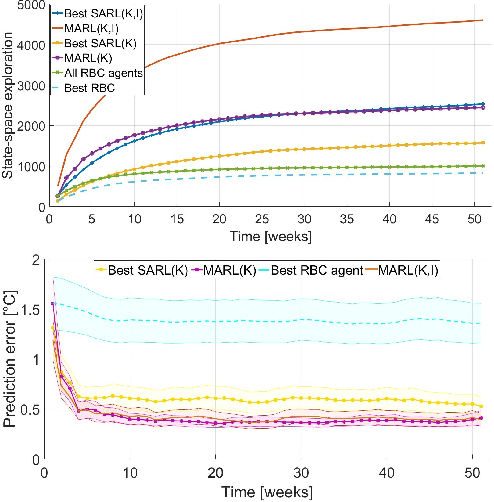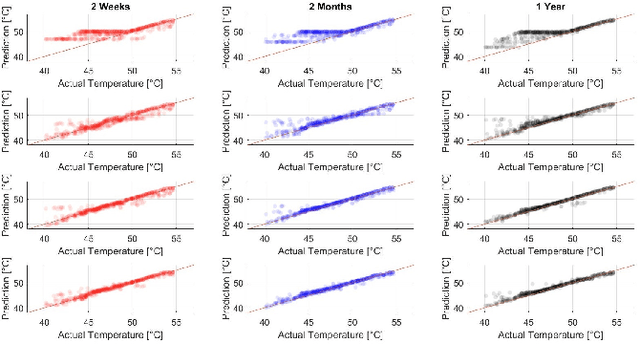Johan Driesen
SolNet: Open-source deep learning models for photovoltaic power forecasting across the globe
May 23, 2024Abstract:Deep learning models have gained increasing prominence in recent years in the field of solar pho-tovoltaic (PV) forecasting. One drawback of these models is that they require a lot of high-quality data to perform well. This is often infeasible in practice, due to poor measurement infrastructure in legacy systems and the rapid build-up of new solar systems across the world. This paper proposes SolNet: a novel, general-purpose, multivariate solar power forecaster, which addresses these challenges by using a two-step forecasting pipeline which incorporates transfer learning from abundant synthetic data generated from PVGIS, before fine-tuning on observational data. Using actual production data from hundreds of sites in the Netherlands, Australia and Belgium, we show that SolNet improves forecasting performance over data-scarce settings as well as baseline models. We find transfer learning benefits to be the strongest when only limited observational data is available. At the same time we provide several guidelines and considerations for transfer learning practitioners, as our results show that weather data, seasonal patterns, amount of synthetic data and possible mis-specification in source location, can have a major impact on the results. The SolNet models created in this way are applicable for any land-based solar photovoltaic system across the planet where simulated and observed data can be combined to obtain improved forecasting capabilities.
Deep Reinforcement Learning for Optimal Control of Space Heating
May 10, 2018



Abstract:Classical methods to control heating systems are often marred by suboptimal performance, inability to adapt to dynamic conditions and unreasonable assumptions e.g. existence of building models. This paper presents a novel deep reinforcement learning algorithm which can control space heating in buildings in a computationally efficient manner, and benchmarks it against other known techniques. The proposed algorithm outperforms rule based control by between 5-10% in a simulation environment for a number of price signals. We conclude that, while not optimal, the proposed algorithm offers additional practical advantages such as faster computation times and increased robustness to non-stationarities in building dynamics.
Valuing knowledge, information and agency in Multi-agent Reinforcement Learning: a case study in smart buildings
Mar 09, 2018


Abstract:Increasing energy efficiency in buildings can reduce costs and emissions substantially. Historically, this has been treated as a local, or single-agent, optimization problem. However, many buildings utilize the same types of thermal equipment e.g. electric heaters and hot water vessels. During operation, occupants in these buildings interact with the equipment differently thereby driving them to diverse regions in the state-space. Reinforcement learning agents can learn from these interactions, recorded as sensor data, to optimize the overall energy efficiency. However, if these agents operate individually at a household level, they can not exploit the replicated structure in the problem. In this paper, we demonstrate that this problem can indeed benefit from multi-agent collaboration by making use of targeted exploration of the state-space allowing for better generalization. We also investigate trade-offs between integrating human knowledge and additional sensors. Results show that savings of over 40% are possible with collaborative multi-agent systems making use of either expert knowledge or additional sensors with no loss of occupant comfort. We find that such multi-agent systems comfortably outperform comparable single agent systems.
Deep Reinforcement Learning based Optimal Control of Hot Water Systems
Jan 04, 2018



Abstract:Energy consumption for hot water production is a major draw in high efficiency buildings. Optimizing this has typically been approached from a thermodynamics perspective, decoupled from occupant influence. Furthermore, optimization usually presupposes existence of a detailed dynamics model for the hot water system. These assumptions lead to suboptimal energy efficiency in the real world. In this paper, we present a novel reinforcement learning based methodology which optimizes hot water production. The proposed methodology is completely generalizable, and does not require an offline step or human domain knowledge to build a model for the hot water vessel or the heating element. Occupant preferences too are learnt on the fly. The proposed system is applied to a set of 32 houses in the Netherlands where it reduces energy consumption for hot water production by roughly 20% with no loss of occupant comfort. Extrapolating, this translates to absolute savings of roughly 200 kWh for a single household on an annual basis. This performance can be replicated to any domestic hot water system and optimization objective, given that the fairly minimal requirements on sensor data are met. With millions of hot water systems operational worldwide, the proposed framework has the potential to reduce energy consumption in existing and new systems on a multi Gigawatt-hour scale in the years to come.
 Add to Chrome
Add to Chrome Add to Firefox
Add to Firefox Add to Edge
Add to Edge